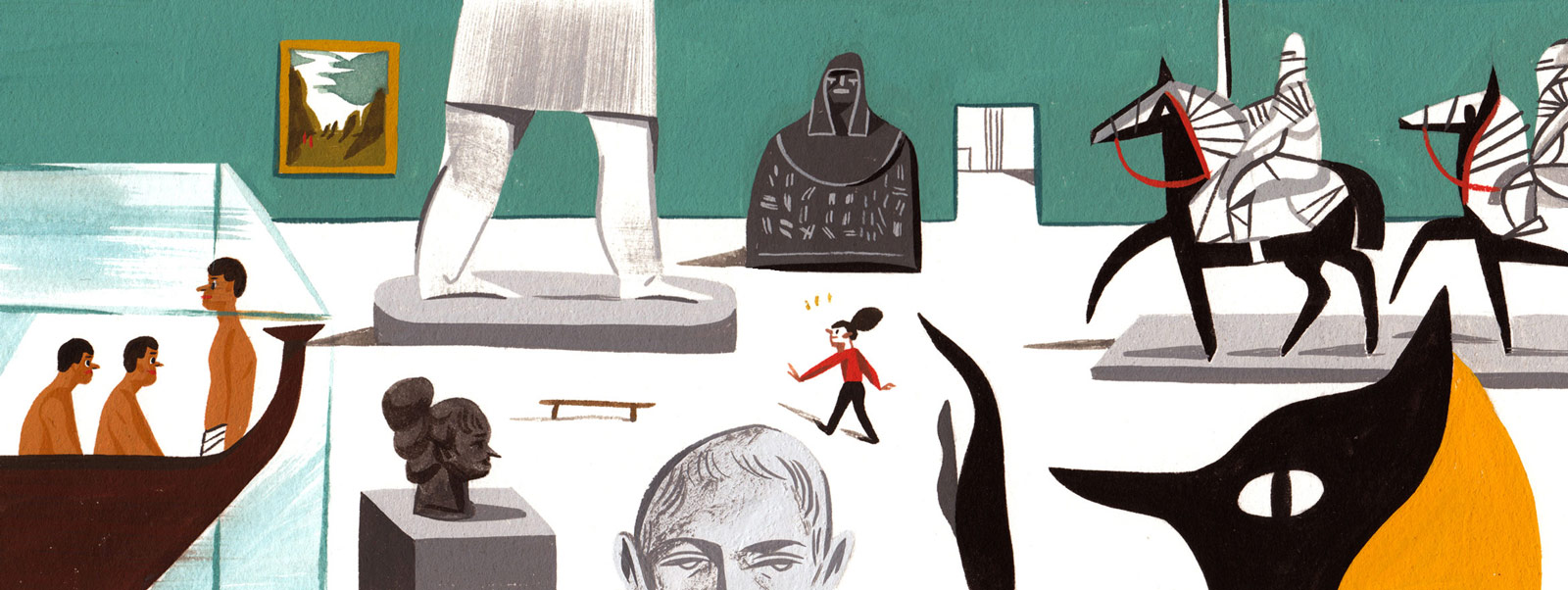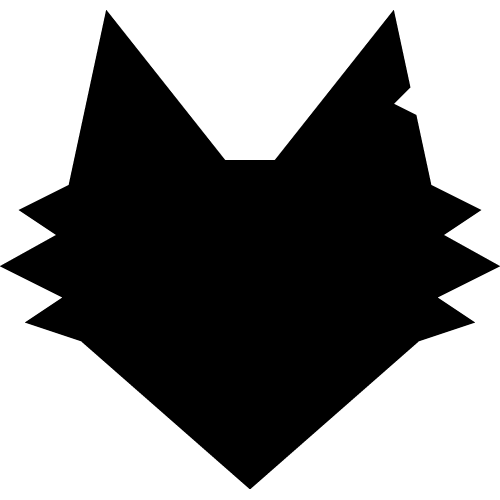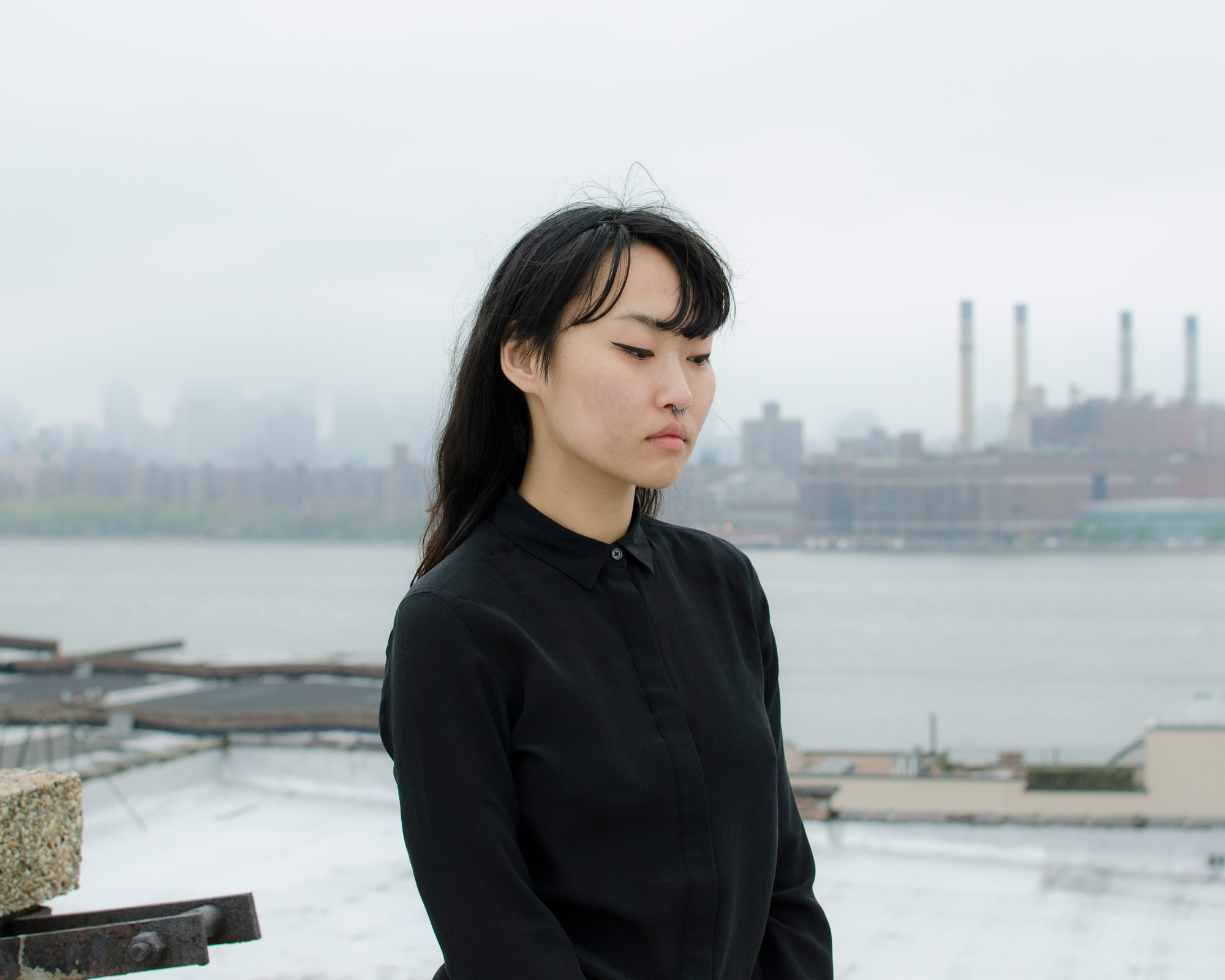
- Interview by Tina Essmaker May 13, 2014
- Photo by Leandro Castelao
Ping Zhu
- illustrator
Los Angeles native, Ping Zhu, is an illustrator currently based in Brooklyn, New York. She is a graduate of Art Center College of Design in Pasadena, California. Her clients include the New York Times, Pentagram, New Yorker, Coach, GOOD Magazine, The Independent, Sunday Times, Pushkin Press, Hèlium, and Nobrow Press. She received the ADC Young Gun in 2013 and her work has been recognized by American Illustration and Communication Arts.
Interview
Describe your path to what you’re doing now.
I studied illustration at Art Center in Pasadena, which is one city away from where I grew up. I came to that decision in high school, when I felt rebellious against how people were defining success. It sounded like academia was the only way to find your way in the world, but I rejected that idea. I wanted a chance to be really good at something, and drawing was one thing I thought I had a chance at. So I drew a lot and started attending portfolio days, which introduced me to the world of illustration. I applied to three art schools, chose Art Center, went there for four years, moved to London for a few years after graduating, and then came back to New York to continue my illustration life.
Let’s talk in more detail. When you were growing up, was creativity part of your life, and how did you decide to focus on illustration?
I wish I could say I drew a lot as a kid, but I never found it to be any more interesting than other things that kids liked. I actually fell into it because I had friends who took an art class on Saturdays, and I wanted to hang out with them. My mom sent me to the class, but my friends stopped taking the class a year later. I just stayed with it and kept going every Saturday until I was 18. The biggest benefit was that it sharpened my drawing abilities more so than a high school art class would have. It felt good to pretend I had some secret power since I was so average at most things.
Was that in middle school?
I started taking classes near the end of elementary school and continued throughout high school. I also took figure drawing classes in high school when I became more serious about drawing.
Did you consider, or were you encouraged, to study anything else?
Honestly I think it was the latter. I grew up in a Chinese family, and I’m the oldest child. My parents come from a conventional background where, if you can’t do what you’re given well, then it’s hard to convince them that you can do what you want well. It’s a way of showing responsibility, and it was how they were brought up. I disagreed with it because I didn’t like the idea of doing something I didn’t enjoy or feel passionate about when I had all these feelings for something else. My parents wanted me to consider other occupations and have a backup plan, but I wanted to follow my instincts and see if that would lead to something good. I know my parents wanted me to sustain myself in what I pursued; they were worried. In the end, I won the argument: I told them I felt like I had a better chance at making a bigger wave in the arts than in academics. I didn’t apply to any academic schools, and I got into all three art schools I applied to. That felt like my first breakthrough on this alternative career path.
What has been your path from graduating college until now?
When I was still in college, I came to New York to visit a few art directors and see if I could really hustle like an illustrator. One of the places I visited was the New York Times when Leanne Shapton was still there. The day before I left, she asked me to do the Letters1 piece, and that was my first encounter with the real illustration world. Someone gave me money to do what I wanted to do, and it was amazing.
And while you were still in school!
Yeah. It was thrilling, even though the piece was the size of a postage stamp. I called my mom and asked her to buy the paper. I had brought all my painting materials with me to New York in case I got a job, but I didn’t actually think it would happen. I remember running to find a Kinko’s to use a scanner and send the file because I was staying with a friend who didn’t have anything except a laptop. It’s fun looking back over the past four or five years because I’m still working with the Times; it’s been a nice relationship to have.
Have you always freelanced?
Yes, I have.
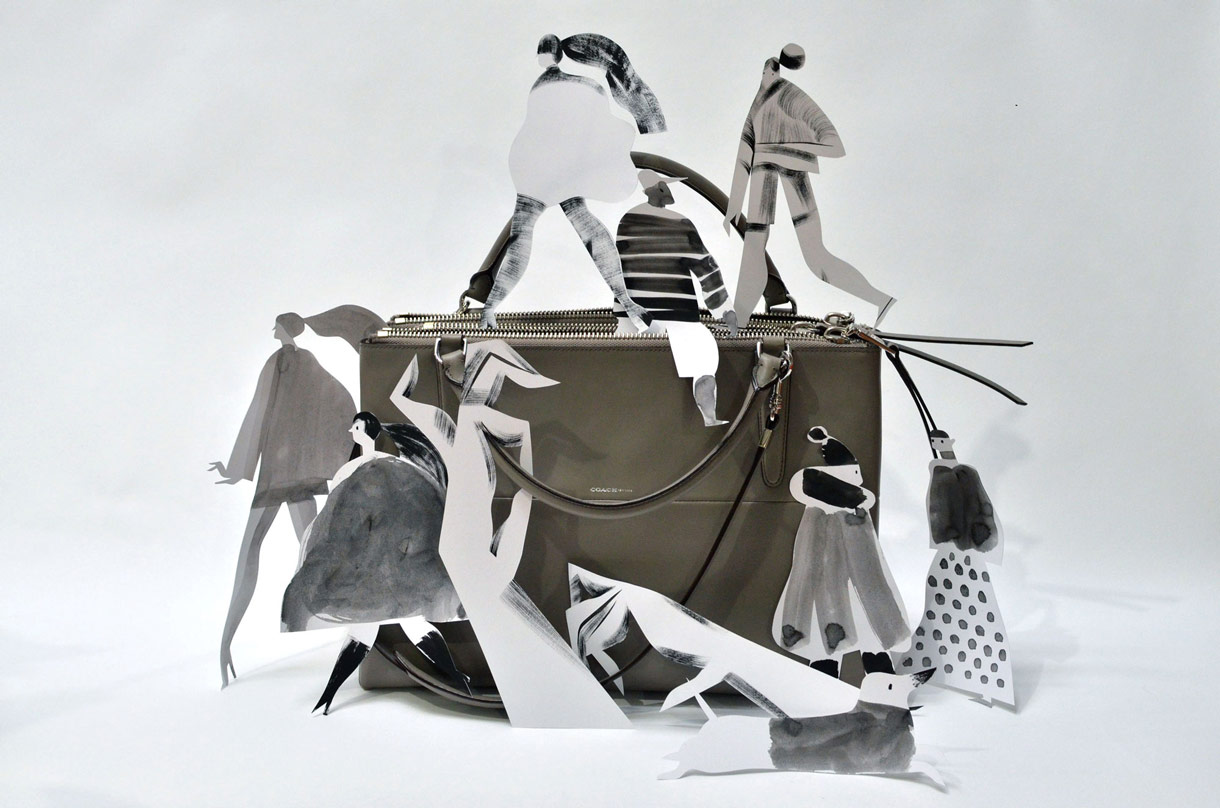
“…I didn’t like the idea of doing something I didn’t enjoy or feel passionate about when I had all these feelings for something else. My parents wanted me to consider other occupations and have a backup plan, but I wanted to follow my instincts and see if that would lead to something good.”
And you moved to London after school. Why there?
It was a once-in-a-lifetime opportunity that I didn’t want to miss. I had been out of college for a few months, and moving to London was like starting from square one again. During school, I had built up so many experiences that helped me feel confident. I was comfortable with my friends and my surroundings. In moving, I wanted to test and push myself so that I didn’t plateau or lose momentum. It was a big reality check. I realized that maybe moving away from all of my friends and family wasn’t the easiest, but I kept treading water while I was away. I didn’t do it alone, either; I have Otto Boreson to thank for helping me through a lot of the rough patches.
That’s a big move.
It was. I grew up east of Pasadena, but went to school in Pasadena. It was very familiar to me. I lived at home when I was in college, too, so I was used to being around my family. The perk was being able to come home to a cooked meal. I miss that now. (laughing)
I wish that still happened. So, how long were you in London?
Three years.
And then you came here, to New York?
A few months before I officially moved, I had gone back to Los Angeles to visit family. On the way back to London, I stopped in New York for a week. I wasn’t completely sure if I wanted to stay in London or move on to something new, so I wanted to see if New York was a feasible plan. While I was visiting, I met other illustrators and designers, including some of the people I now share a studio with. Everything slowly fell into place. It confirmed that this was where I wanted to be, and I moved here at the end of September.
Did you have an “Aha!” moment when you knew that illustration was what you wanted to do?
I don’t know if there was one moment, but I started learning about the subtle differences between fine art and illustration in college and finding out that maybe my skills were better suited for an audience rather than expressing myself and my ideas as a fine artist would. I think both are incredibly hard, but I think that I would do poorly in the fine art world because, at this point, it feels like a foreign language to me.
Not too long ago, I went back into my LiveJournal account and found an entry that I wrote when I was about 15 or 16 that said, “I’m going to be an illustrator.” I stated it that day. It was funny to read it now, so many years later. I decided that, but I don’t remember why or what brought me to that conclusion. I’m not sure if it was me realizing it or if others were recognizing it in me and telling me.

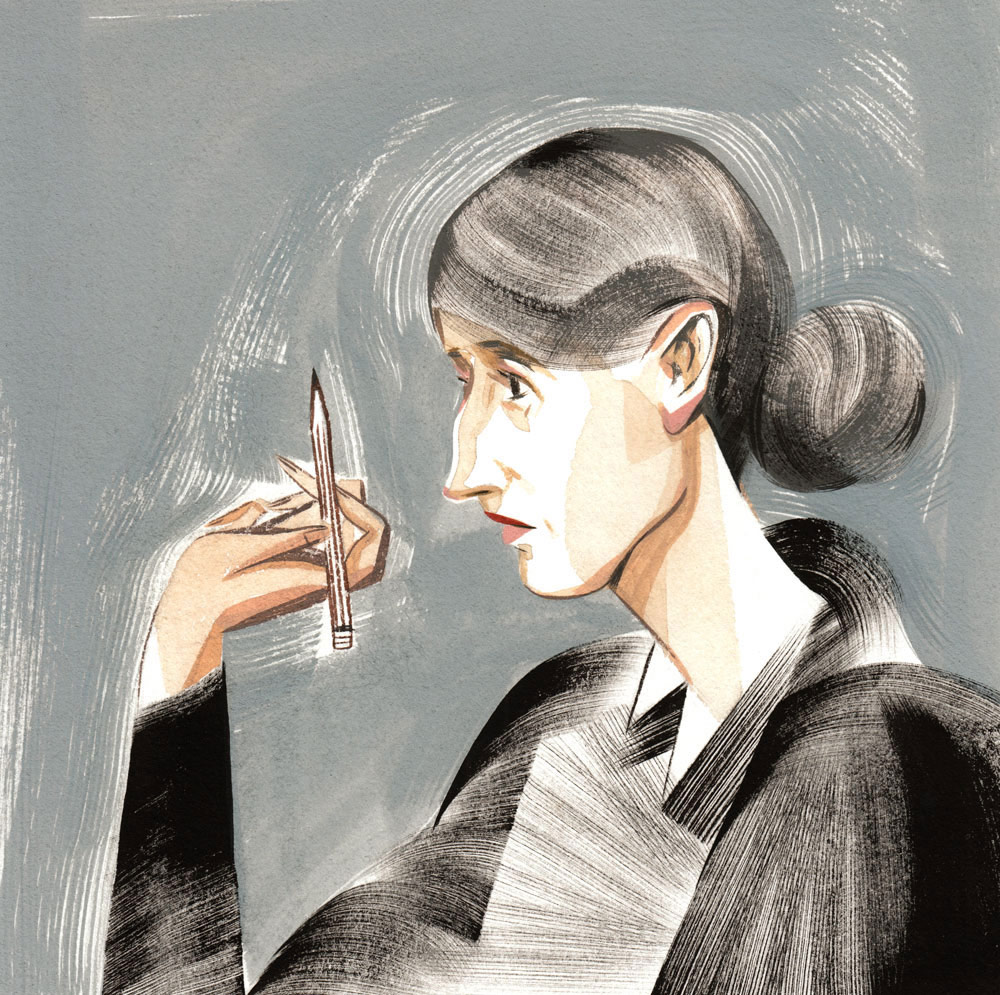
Have you had any mentors along the way?
I think a few of my instructors from school helped a lot. In my second or third year, I took an illustration course taught by Paul Rogers. The course applied graphic design elements to illustration, so it wasn’t just narrative drawing and painting. His attitude was more relaxed and hands-off. If you didn’t care about the class, he wasn’t going to push you to make you care more. I liked that because you got what you wanted out of it.
I also took an op-ed class taught by Brian Rea and Paul Rogers. Brian used to be an art director at the Times before he moved to Los Angeles. The class was based around the op-ed page in the Times, and that helped a lot in terms of work ethic and concepting on the fly. It’s a layered type of assignment where you have to come up with an idea in two hours, draw it, explain it, and not lose your head in the process. That class was good and accurate practice in preparing me for assignments with short turnarounds. When I finally got my first op-ed assignment, I felt like I was in somewhat familiar territory.
And what about once you were out working in the real world? Did you have anyone help you regarding the business side of things since you went straight into freelance work?
I had an agent shortly after I graduated, so I had someone to help me with the things I was unfamiliar with: spreading the word about myself as an illustrator, budgets, contracts. Those things were hard for me to sort out in the beginning because I didn’t have a way to measure the right price for a job, et cetera. It’s uncomfortable to ask others what they charge, and not everyone is open to talking about it.
Did you seek out an agent?
She approached me and also represented my instructor and mentor, Paul. I had expressed interest in having help, but never directly asked for an agent. No one in college offered that as a solution or even an option. I met her at ICON in 2010 and we talked briefly and had a nice connection, so I decided to try it and see if it worked for me. I worked with that agent for three years, which were some really important years. After that period, I decided to do things on my own. There were different reasons why, but it was mainly because I’ve never freelanced alone and I wanted to know what it was like. It’s like tasting anything for the first time, and hearing someone’s description of it isn’t the same as actually doing it yourself.
[speaking of tasting things, a tasty cheese board arrives and we dig in]
I love cheese, but my parents don’t like it. They didn’t grow up eating dairy in China, so there was a lot of soy milk and tofu in the house when I was growing up. I guess it would have been pretty easy for me to become vegan.
Both of your parents grew up in China?
Yeah. My dad came to the US for college at the University of Washington in Seattle, where I was born. Then we moved to Rhode Island, where my dad earned his PhD; and my brother was born there. Then we zig-zagged across the country to California for my dad’s job at JPL in Pasadena—that’s the Jet Propulsion Laboratory. Both of my parents studied meteorology, which is also why it probably didn’t make sense that I wanted to do art.
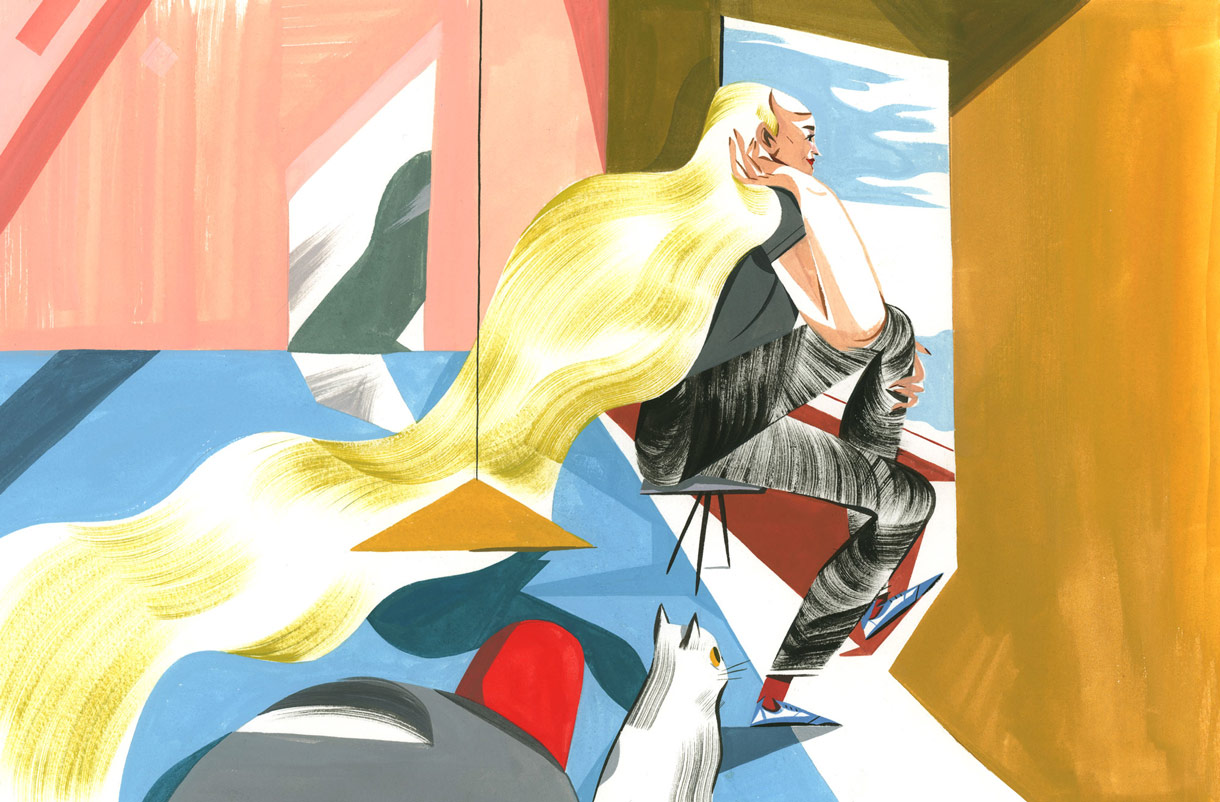
“I did have a lot of resistance from my parents, which I understand. I don’t think they were unsupportive, but they wanted to make sure that I was sure.”
Is there anyone in your family who has worked in a creative field?
I don’t think so. Most of my extended family is in China and has always been. Unfortunately, I’m not close enough to them to know exactly what they’re involved with. The culture there is about working and surviving and providing; it’s not as focused on encouraging your passions. To me, illustration is a way of communicating to make the world more connected and cultured, and it colors the world. But as far as survival and priorities, it seems impossible to think that illustration would be accepted as a way to support your family in China in the 1970s when my parents were growing up.
Pursuing the arts wasn’t an option for either of my parents, but my dad has an admiration for the arts. When I was growing up, he was actually the one who took me to museums. One of my first memories was of waiting in line with him at the Los Angeles County Museum of Art (LACMA) to go see a Van Gogh retrospective when I was 10 or 11 years old. I was barely tall enough to see the paintings properly, but it was such an interesting experience. As I got older, we went to other shows and discussed the work together. My mom on the other hand is so rational, but, in a way, that limitation has resulted in creative solutions for completely banal things. She’s always been excellent at organizing, so maybe that counts!
That’s really cool. I’ll ask this question now since we’re already talking about it. Are your family and friends supportive of what you do?
My dad is more empathetic towards my wanting and, in a way, my needing to do illustration. I fit other molds so poorly. It’s natural for me to go toward what I feel is right. I did have a lot of resistance from my parents, which I understand. I don’t think they were unsupportive, but they wanted to make sure that I was sure. They challenged my beliefs a lot because of that. I wanted to prove that there was an alternative way of succeeding, which is probably why I have a hard time giving up.
I don’t think my friends were unsupportive; they just ended up going their own ways. And to be perfectly honest, I didn’t have a lot of friends in high school. I think my few friends were fascinated with my choice of direction and wondered how I would sustain myself.
Most people don’t mean to be unsupportive, but, at the same time, they don’t fully know what it means to freelance. “What do you mean you don’t have a boss?” There were a lot of things to explain once I had a better grasp of it. Over the past few years, my folks have become more relaxed about what I do and they don’t ask me as often as before if I’m out of money. (laughing) It’s good to know that they’re there for me. I wouldn’t have been able to go to college if it hadn’t been for them, so I owe them a lot.
It probably helps that they can now see your work in major publications.
Yeah, for sure. It’s nice to be able to tell them, “I’m doing a piece for the New Yorker, so go and buy this issue!” They actually bought a subscription to it because I’ve done a few illustrations for the magazine. I guess that they are my biggest fans. It’s sweet. I still know, though, that it’s difficult for them to explain what I do to friends and family.
It’s also difficult because things are evolving quickly. When I started college, social media wasn’t a tool yet. Now that it is and more people can see your work, it also speeds up the demand. The majority of the work I do is by hand, and I’ve felt the pressure from art directors and clients who want more within the same time frame and at the same quality as if I had a week to do it.
Have you taken any big risks to move forward?
As far as my process goes, painting with gouache means I’m taking tiny risks every time the paint touches the paper. It’s pretty permanent, so if it’s not what I want, I have to work around it or start over. The nature of my work is gestural and the effect of dry brushing is unpredictable, even if I try to control it. The result is always a little bit unknown.
I think risks around life decisions, like moving to London and moving away from London to come to Brooklyn, have been substantial. Deciding where I want to be to create work is a heavy decision, because if I’m not enjoying my environment, then my mood will suffer, which will seep into my work. It’s a vicious cycle! I try to measure the distance of how far I’m jumping before I do it, but you don’t ever really know how it’s going to turn out. So far, so good.
What advice would you give to someone starting out?
Maybe this is more like things to keep in mind. It takes an extreme amount of hard work and confusion, and sometimes suffering a bit, to realize what you want. Our lives are not meant to be comfortable. In the end, if it’s really what you want, you’ll come out with all your scars and have something to show for it.
Do you feel a responsibility to contribute to something greater than yourself?
What I do is more of a privilege than a responsibility: if I dropped out of illustration, someone would quickly fill my spot and the world would go on without me. I feel proud to be able to do something for other people, so if it is a responsibility, I’ll take it.
The work itself involves creating a bridge between people who consume and people who create; as illustrators, we are handing off a baton every time we make a piece of work. It’s nice to imagine saying to someone, “Ta-dah! See how I see the world for just a moment.” Maybe someone can respond to or be inspired by that? I remember seeing the small, subtle illustrations while reading the New Yorker when I was younger and thinking, “Someone did that! How did they do that, and why do I feel so much emotion towards it?” They are small, unintentional messages that people pick up and keep.
Have you had a chance to do any speaking or teaching?
I gave some small talks in the Art Center classes when I went back to Los Angeles last year, and I spoke at Pratt Institute and School of Visual Arts (SVA) because a few of my friends teach courses there. I haven’t talked in front of a huge audience before, but it’s definitely something I would like to do in the future.
People have asked me if I would like to be a teacher, and I would, but I’m not sure what I would teach. Being able to paint and draw is a technical skill, but being able to come up with ideas and explain ways of thinking is a whole new thing. I’m not sure if I’m good enough in either of those to teach them, but I would do it if someone trusted me enough. (laughing)
Are you creatively satisfied?
I’m not dissatisfied, but I don’t feel like I’ve reached my creative potential. That’s probably the reason why I listen to so many podcasts and am so in awe of everything: I need to learn more about the world I live in to find more creative solutions.
I’m definitely someone who enjoys positive responses or helpful criticism, but, ultimately, I don’t like to discredit the current moment. In a good moment, it’s important to pat yourself on the back and then move on. Try not to destroy yourself on a bad day. There’s no way to pretend that you can be your future self right now. For that reason, I try to contain my satisfaction and dissatisfaction within whatever is in front of me. Some days, I feel like my brain is stuck where I don’t want it to be, and other days I’ll think, “Whoa, where are all these goodies coming from?” So, sometimes I’m satisfied. (laughing)
“It takes an extreme amount of hard work and confusion, and sometimes suffering a bit, to realize what you want. Our lives are not meant to be comfortable. In the end, if it’s really what you want, you’ll come out with all your scars and have something to show for it.”
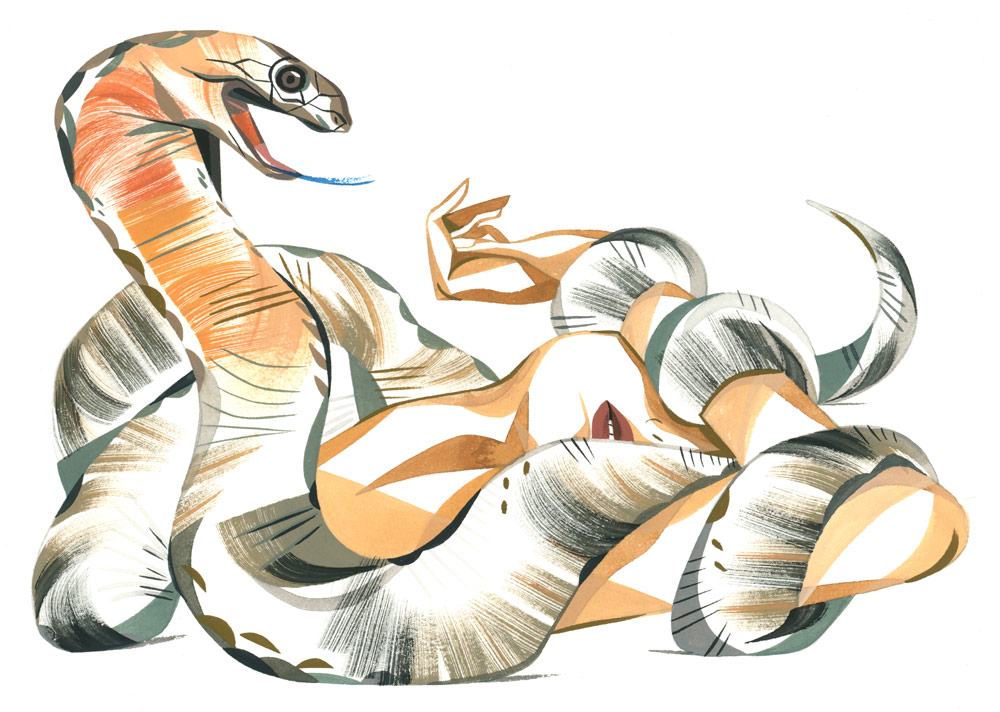
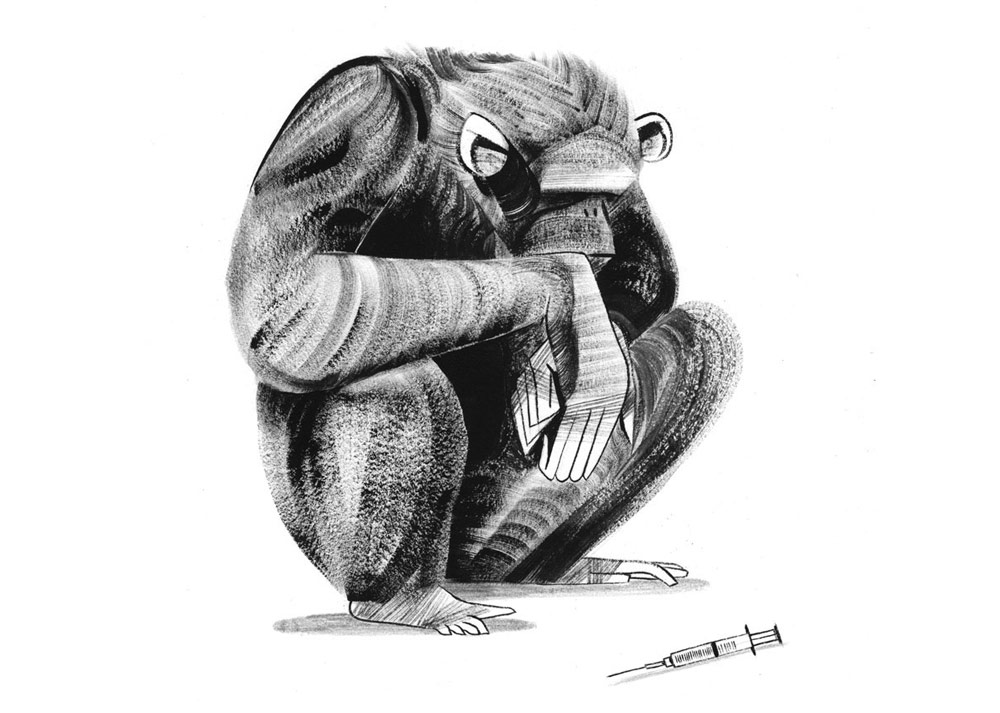
It’s a balance between being happy to do the work you get to do, but always wanting to improve and do more.
I know. I enjoy spending my time doing something of value rather than volume, but it’s hard, especially with this kind of work. When you’re starting out, you’ll be the bottom feeder and take whatever comes your way, but later on it becomes hard to edit what will be better for you in the long run. You can receive a bunch of awards and recognition from people who say you’re doing well, but does that still count if you’re not satisfied with what you’re doing?
How does living in Brooklyn impact your creativity or your work?
I’ve always liked big cities, probably because I like being able to see people. We’re social creatures, and deep down in our animal selves, we want to know that we’re not alone.
I also thrive on seeing the unexpected, and New York is one of those unpredictable places where you can see something amazing or inspiring or totally disgusting every day. I enjoy that I can step out of my house, walk the same route every day, and it will be different depending on the hour. In general, New York is never the same twice, and I like those fleeting moments. They tie into how fast everything moves.
This place reminds you that you’re alive, and that, in turn, inspires me when I go into the studio. It’s crazy to think that I’m here making work while people are bustling around everywhere, and the energy of that seeps into my work. I didn’t feel that as much when I was in London, and I certainly didn’t feel that way in Los Angeles.
Is it important to you to be a part of a creative community of people?
Yes, but I don’t want to be in the center of it. I enjoy being a little bit more behind the scenes. I use Twitter and social media a lot to send messages, telling people I like something they did, or sharing little doses of my personality that I can distribute at my leisure. I also prefer having people call me out instead of me crashing in. In New York, it’s nice to attend a lot of social events and take part, but I don’t want to go to all of them because I don’t want to exhaust that good, excited feeling about seeing people. Some of my best moments here have been shared with folks in the creative community, but not discussing work related topics—that’s refreshing and necessary.
Are the people you work with at the studio a big part of your community?
Definitely. It’s great to know that it’ll be a rare moment if I’m there alone. I share the studio with Liz Meyer and Gavin Potenza, who just merged to form Script & Seal, and Dan Cassaro and Leandro Castelao, an illustrator from Buenos Aires. Jessica Hische is there when she’s in town—Ben Barry is currently subletting her desk when she’s not here. There’s a nice mix of illustration and design folks. When I first came in, I thought, “Argh! These are superstars! I can’t be in here!” Now, they’re friends who I’m always pestering to go to lunch with me.
“…painting with gouache means I’m taking tiny risks every time the paint touches the paper. It’s pretty permanent, so if it’s not what I want, I have to work around it or start over. The nature of my work is gestural and the effect of dry brushing is unpredictable, even if I try to control it.”
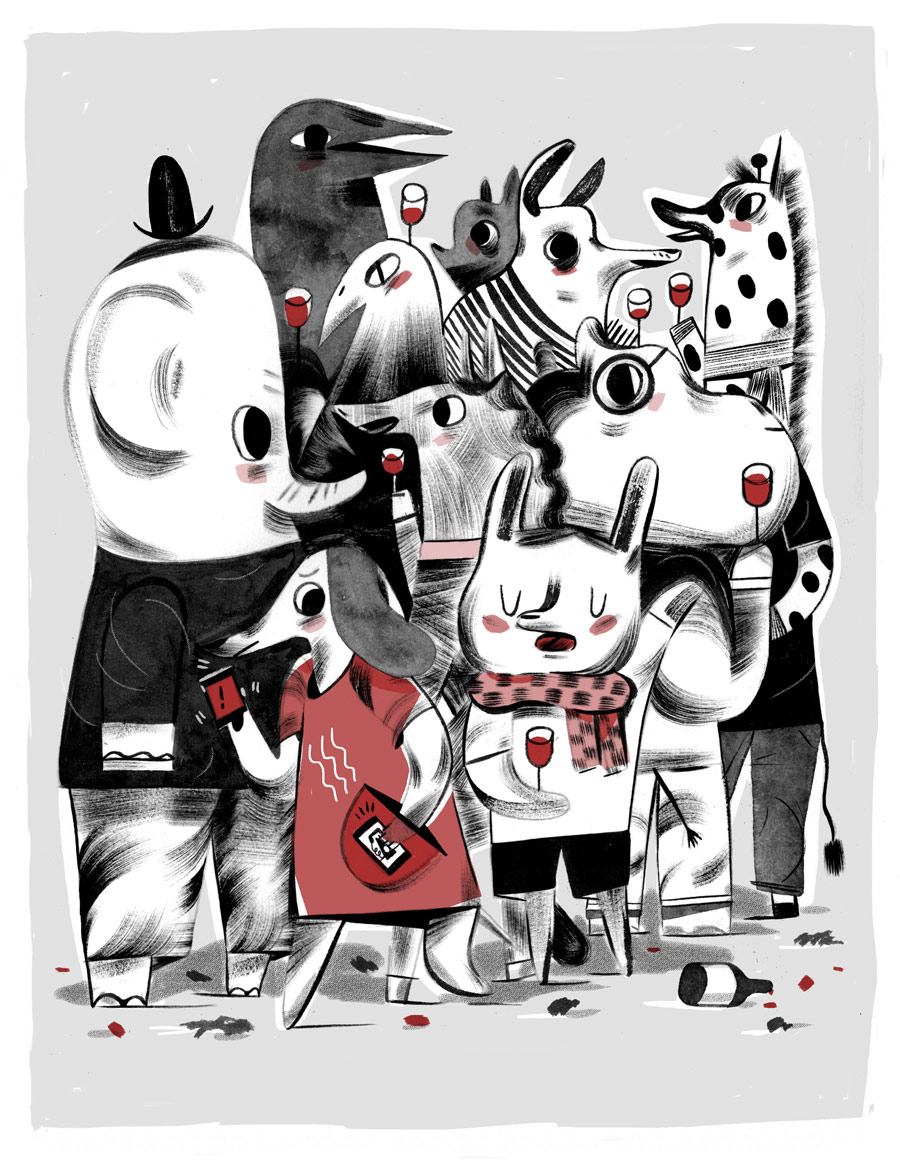
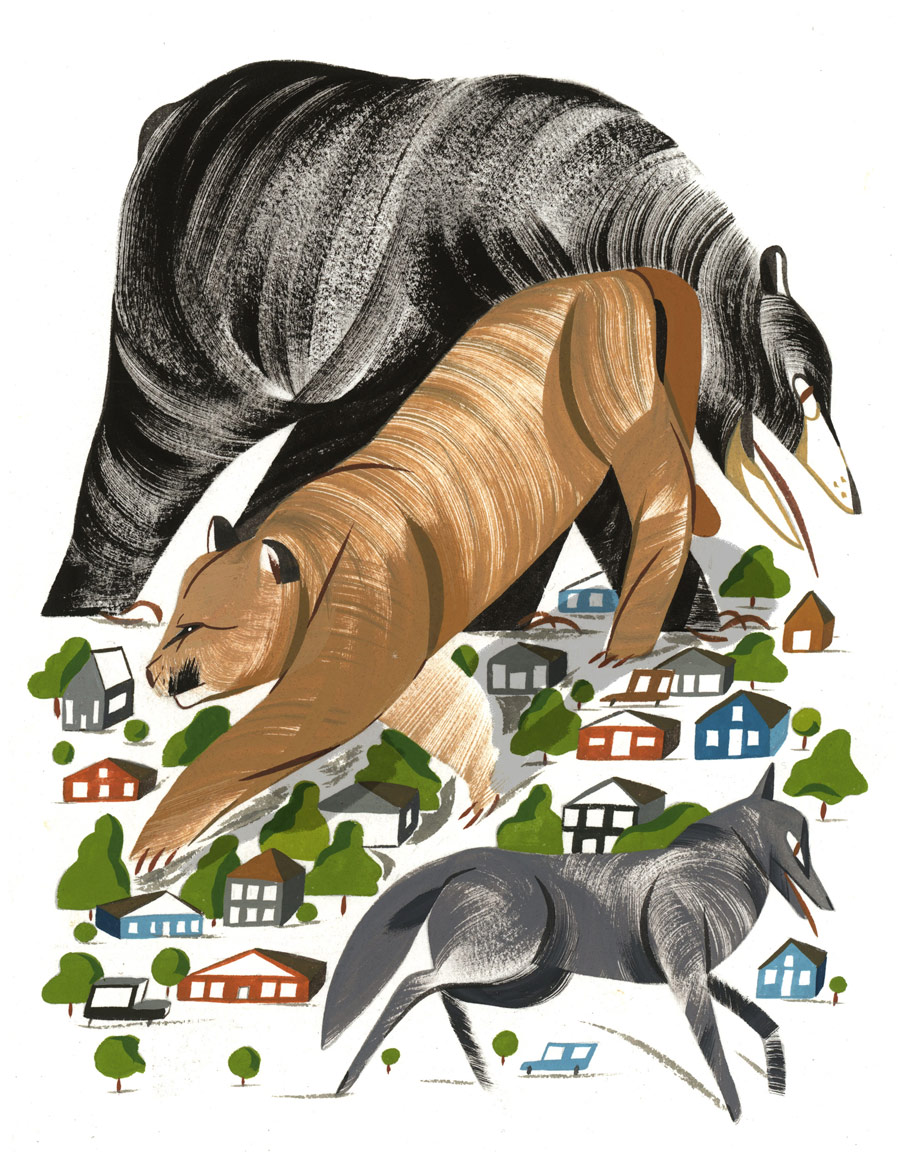
It would be nice to be in a space where you could get out your tools and start sketching or painting.
I think I represent what a kindergartener would look like with all my paint and supplies flying around. Others in the studio work on computers, but everyone has a phase of their process that they do by hand. The space isn’t just a bunch of desks, either: it has a skylight and feels like a cozy loft. It’s a comfortable place. There’s also a foosball table that Dan bought, so we have a recreational area as well. We have nice moments when we’ll all get up and make coffee or take a break and then mosey back to our desks. It’s good to not feel crazy looking at my own work all day anymore—I don’t have to think, “Ugh, I need a second opinion right now, but I can’t ask Twitter.”
What does a typical day look like for you?
Lately, I’ve been waking up around 7am to get up and shower. I actually get everything ready to go the night before so I don’t have to make decisions when I’m not totally awake yet. For instance, I’ll pick what I’m going to wear and put it in a pile so I can just get dressed and leave the house as fast as possible. I sleep better that way.
Once I leave the house, I take the train to work, which is a 40-minute ride. Ideally, I like to get into the studio before 10am. Once I’m there, I listen to music or podcasts and work for two to three hours before getting lunch, usually with other people. I cherish my break times and like to enjoy my lunches. Sometimes I answer email in the morning and take the occasional phone call in the afternoon, but nothing too crazy. I work best in two to three-hour sessions and try to get up and stretch my legs every once in a while. I’ve been trying to leave the studio earlier, around 6pm while the sun is still out, although sometimes I have weird days where I have to stay super late. Unfortunately, I’ve been working weekends lately, but hopefully that won’t last forever.
When I moved here, I decided not to have Internet at my apartment, only at the studio. I use my phone to check email, but I don’t actually produce work at home. I needed a physical separation between life and work and having those kind of boundaries help me to stay sane. When everything blends together and you’re getting notifications all the time or people are asking for things from you, it’s hard to stop all of that noise. Home is for reading and relaxing. If something does come up last minute for work, I’ll go into the studio and work on it. Otherwise, I let people know that I’m not available 24/7. I need space for myself.
I think there’s a difference between being busy and being productive. I want to be aware of my productive moments instead of just moving windows around on my screen and tricking myself into thinking I’m working. With that thought, I like to plan my days to make sure I have a to-do list so I can physically see what needs to be done. It’s nice to feel in control and therefore satisfied when I’ve checked everything off. I cherish the days when nothing is due and I can wake up a little bit later or not go in at all. Now that the sun is out, it’s very tempting to be outside more because the city is coming to life again.
What music are you listening to right now?
I’ve been listening to Todd Terje, who is a Norwegian electronic music-maker. I prefer neutral tunes when I’m working—electronic blips or songs in different languages—because words can sometimes throw me off and give me too many feelings. I typically enjoy upbeat melodies, and sometimes turn to classical music, like Dvořák.
Any favorite movies or TV shows?
I have fallen behind on TV shows because of my lack of Internet at home, but the last series I watched was Parks and Recreation.
That show is hilarious.
I think it gets better every season. I like the dynamics, and I prefer lighthearted shows because I don’t like putting myself in situations to feel miserable. I try to avoid that as much as possible because I feel like I can do that all on my own, without TV shows and music. (laughing)
For movies, I think the last one I watched was Her. Even though it was sad and melancholy, it was still somehow pleasant. I enjoyed it as a reflection of what it means to be human. I like movies that make me think and reflect a little bit; I like those small reminders, even if it’s only a story. We can put ourselves into stories and wonder, “Is that my life right now?” Or, “Is this related to me in some way?”
Do you have any favorite books?
I’ve always enjoyed In Cold Blood by Truman Capote. I had to read it in high school, but I was drawn to it even back then. Maybe it’s my deep-seated, morbid roots, but there’s something about the brutal premise of what happened to that family, and the investigation afterwards. I like the way the story was told. As much as I enjoy happy music or movies or TV shows, I also enjoy the truly sad, far end of that spectrum.
I recently finished reading Never Let Me Go by Kazuo Ishiguro, which is a beautiful and sad science fiction story. I also read reading Malcolm Gladwell’s What the Dog Saw. It’s a collection of essays he wrote for the New Yorker. The title reflects one essay analyzing human behavior and our body language, but using Cesar Milan’s relationship with dogs as an example.
Right now I’m reading a nonfiction book called Flow: The Psychology of Optimal Experience by Mihaly Csikszentmihalyi. The idea of flow is defined as the happy state of mind when people are focused on something and nothing else matters. The book is about how to find that equilibrium when you’re working. Since the beginning of time, people have been asking, “What makes us happy?” Why do we buy things to fill that void? This book analyzes moments in people’s lives to figure out when we’re at our peak, and then it tries to maximize those moments so we can experience flow more often.
Do you have any favorite foods?
I can eat pasta at any given moment. I really like bolognese or any kind of ragù, especially if it has slow-cooked lamb in it. Ramen is also irresistible, and always worth the wait.
What kind of legacy do you hope to leave?
It would be nice to be remembered as someone who cared about what she did and adapted to situations with her work. It’s not about finding ideal situations to put myself in, but being able to jump over obstacles, become more flexible, and learn as an open-minded illustrator. My work is a product of how much I care about what I’m doing more so than how much I’m trying to please other people. I want my work to have been a natural result of my creative medium. I don’t think I’ll have the same freedoms and misery doing anything else, so if we only have this one life to lead, I want to have made the most of it.
